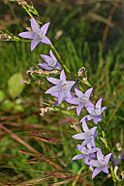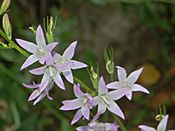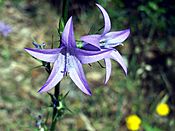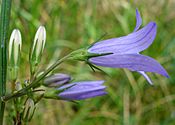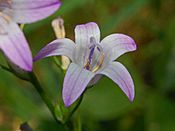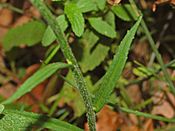Campanula rapunculus facts for kids
Quick facts for kids Campanula rapunculus |
|
|---|---|
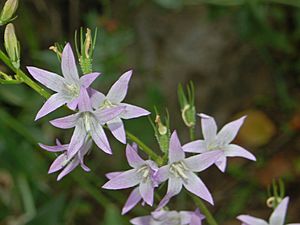 |
|
| Scientific classification | |
| Genus: |
Campanula
|
| Species: |
rapunculus
|
Campanula rapunculus, often called rampion bellflower or just rampion, is a type of bellflower plant. You might also know it as rapunzel, which is where the famous fairy tale got its name!
This plant was once very popular in Europe. People grew it for its leaves, which they ate like spinach. They also ate its root, which looked a bit like a parsnip or radish.
Contents
What's in a Name?
The name Campanula comes from Latin and means "small bell." This is because the flowers look like tiny bells! The second part of the name, rapunculus, means "little turnip." This refers to the plant's root, which is shaped like a small turnip.
Meet the Rampion Bellflower
The rampion bellflower is a biennial plant. This means it lives for two years. It grows to be about 40 to 80 centimeters tall, but can sometimes reach up to 100 centimeters. Its stem stands straight and might have a few hairs. It branches out near the top.
The leaves at the bottom of the plant are shaped like an egg and have small teeth. They grow in a circle close to the ground. The leaves higher up on the stem are long and narrow.
The flowers are light blue or violet and shaped like bells. Each flower is about two centimeters long. They grow in clusters along the stem, usually facing one way. You can see these pretty flowers from May all the way through September. After the flowers, the plant produces a fruit that looks like an upside-down cone. This fruit holds many tiny seeds. The plant also has a thick, edible root that looks like a small turnip.
Where Does it Grow?
You can find Campanula rapunculus in western Asia, northern Africa, and most parts of Europe. However, it doesn't grow naturally in Iceland, Ireland, or Norway. It has been brought to places like Denmark, southern Sweden, and Great Britain. As mentioned, people used to grow it widely in Europe for its edible leaves and roots.
Where it Likes to Live
This plant prefers to grow in soil that has a lot of limestone. You can often spot it in dry meadows, gardens, and forests with oak and pine trees. It also likes to grow along roadsides and paths. You can find it from sea level up to about 1500 meters high in the mountains.
Gallery
See also
 In Spanish: Rapónchigo para niños
In Spanish: Rapónchigo para niños



